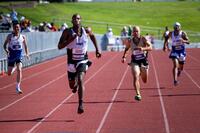Every year, thousands of Americans attend basic training or boot camps in all branches of the military as they prepare to serve their country. Thank you for your choice to serve. However, there are typically two mentalities upon arriving at basic military training.
1. Boot camp will get me in shape.
2. Boot camp will get me out of shape.
The boot-camp suffering
A majority of young Americans have treated boot camp as a weight-loss clinic and suffered needlessly for several weeks with PT sessions, running, marching and load-bearing rucking, depending upon your branch of service. These events can seem endless for the unprepared and deconditioned recruit.
Statistics will show that you are quite lucky to endure the entire basic training without failing events or getting injured to a point where you could not continue with your fellow recruit class. That is, if you show up not ready to perform at a moderate to high level of fitness.
Consider these standards for the variety of events in all military programs:
Events |
Men |
Women |
|
Push-ups |
80+ |
50+ |
|
Sit-ups/crunches |
80+ |
80+ |
|
Pull-ups |
10+ |
At least one |
|
1-mile pace for timed runs |
6-7 minute miles |
7-8 minute miles |
|
Rucking pace |
12-13 minute mile pace |
15 minute mile pace |
Note: These are not the military minimum standards. These are of the opinion of the writer who has prepared young men and women for success in military, police and firefighting training for more than 20 years. If you can push these numbers and times, you will have no problem with the physical training at basic military training programs.
Related Video
Do not think boot camp will get you in shape. If you do, you are asking for miserably long days. If you survive, though, you will be in the best shape of your life and likely come close to those numbers in the chart.
Why add to the stress of boot camp? At boot camp, you likely will be on your own for the first time, living in barracks with several strangers (at first), highly active all day long, homesick and receiving a daily dose of negative feedback from instructors. Why add injury or physical fatigue to that list?
The boot-camp taper
For those highly prepared for their military service and perhaps moving in the special-ops side of the military in their near future, going to basic training at a high level of fitness is a requirement. Basic should be relatively easy, and if highly prepared, you can use your first few months in the military as a physical taper.
Then when you are finished and moving on to bigger physical challenges, it will not take that long to get back into that high level of conditioning. There are some things you can do to keep working out hard. Try doing push-ups, sit-ups and flutter kicks on the floor in your barracks whenever you have some time -- even if it is 10-15 minutes before bed or waking up. I
f you can get laundry duty, you will have big bars to hang clothes on that are sturdy enough on which to do pull-ups. Laundry duty can add to your ability to get a few pyramid workouts in the day when you need it.
Advice for all recruits at basic training
1. Do not get sick. If you can avoid getting sick, you will be ahead of the curve in the more challenging physical events of training. Plus, if your goal is to move onto the special-ops side of the military, getting sick can decrease your ability to recover quickly.
- Wash your hands frequently.
- Do not touch your face with your hands unless when washing.
- Use hand sanitizer whenever you see it.
If you do get sick, it is not the end of the world. Just focus on getting well fast and recover from each day of training by eating well at the chow hall and sleeping (when you can).
2. Failing to prepare is preparing to fail. Just work out before going to basic training. It does not have to be a hard-core workout, but it does have to involve push-ups, crunches and running. Add in more exercises like pull-ups, flutter kicks, squats and lunges to top off the type of calisthenics workouts you will experience.
You need to get the body used to these events as injuries can occur when the body is exposed to moderate to high repetitions of these calisthenics for the first time. See ideas with the PFT bible for all branches of service.
3. Are You Really Ready? Before you see a recruiter, make sure you are really ready. See 10 signs you are ready to serve.
4. Train specific. Depending upon your branch of service and your job, you may need extra physical testing to get to and through the training. See some of the latest changes to entry-level PT testing in today’s military.
Stew Smith is a former Navy SEAL and fitness author certified as a Strength and Conditioning Specialist (CSCS) with the National Strength and Conditioning Association. Visit his Fitness eBook store if you’re looking to start a workout program to create a healthy lifestyle. Send your fitness questions to stew@stewsmith.com.
Want to Learn More About Military Life?
Whether you're thinking of joining the military, looking for fitness and basic training tips, or keeping up with military life and benefits, Military.com has you covered. Subscribe to Military.com to have military news, updates and resources delivered directly to your inbox.


















